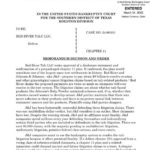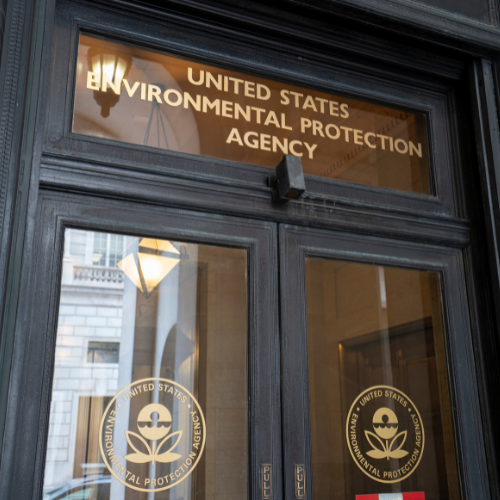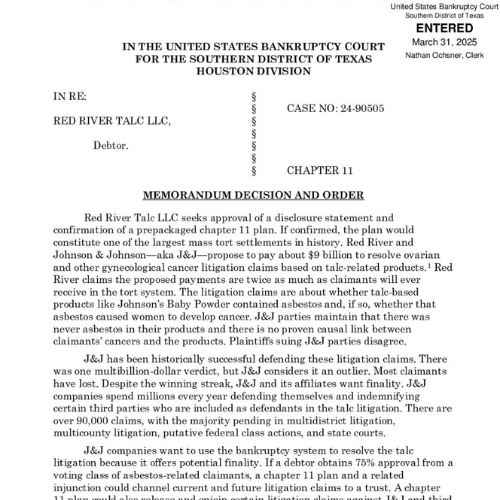
New OSHA Regulations on Silica Exposure: What Workers Need to Know
March 18, 2025
Court Rejects J&J’s Third Talc Bankruptcy Plan in Landmark Toxic Substance Lawsuit Ruling
April 2, 2025Although asbestos use has declined significantly in the U.S., asbestos exposure remains a serious threat in 2025. Many people assume asbestos is a danger of the past, but the truth is that millions of buildings, homes, and industrial sites still contain asbestos materials. As these structures age or are disturbed by renovations, demolitions, or natural disasters, asbestos fibers can become airborne, creating significant health risks.
This blog explores the modern-day risks of asbestos exposure, including aging infrastructure, industrial sites, and natural disasters, and what individuals can do to stay safe.
Aging Buildings: A Hidden Asbestos Threat
One of the biggest sources of asbestos exposure today is aging buildings, including homes, schools, and commercial properties constructed before the 1980s. Many of these structures contain asbestos in insulation, floor tiles, roofing materials, and pipe coverings. As buildings deteriorate or undergo renovations, asbestos fibers can be released into the air, putting occupants and workers at risk.
Common locations where asbestos exposure may occur in older buildings include:
- Public schools and universities – Many educational institutions still contain asbestos in ceilings, flooring, and insulation.
- Government and office buildings – Asbestos was widely used in fireproofing and insulation, posing a risk during remodeling or demolition.
- Older residential homes – Homeowners conducting DIY renovations may unknowingly disturb asbestos-containing materials.
Industrial Sites and Occupational Exposure
Although asbestos use has declined, certain industries continue to pose a risk for workers. Many industrial facilities, power plants, and shipyards built before asbestos regulations took effect still contain asbestos in machinery, boilers, and insulation. Workers in construction, demolition, and maintenance face ongoing exposure risks, especially when handling old materials.
Jobs with higher asbestos exposure risks in 2025 include:
- Construction and demolition workers – Disturbing asbestos-containing materials releases fibers into the air.
- Shipyard workers – Older ships often contain asbestos insulation, gaskets, and flooring.
- Power plant workers – Asbestos was commonly used in turbines, pipes, and insulation, making maintenance work hazardous.
- First responders and disaster relief workers – Firefighters, paramedics, and cleanup crews may be exposed when working in damaged structures.
Natural Disasters and Asbestos Exposure
As climate change increases the frequency and severity of natural disasters, the risk of asbestos exposure grows. Hurricanes, wildfires, earthquakes, and tornadoes can destroy older buildings, releasing asbestos fibers into the air and surrounding environment. In disaster-stricken areas, residents, emergency responders, and cleanup workers face an increased risk of inhaling asbestos.
Recent examples of asbestos risks after natural disasters include:
- Hurricanes and floods damaging older coastal buildings, leading to asbestos contamination in debris.
- Wildfires destroying homes with asbestos siding, insulation, and roofing, releasing toxic fibers into the air.
- Earthquakes causing building collapses, disturbing asbestos materials inside walls and ceilings.
How to Stay Safe from Asbestos Exposure
Although asbestos risks persist in 2025, individuals can take steps to protect themselves and their families:
- Avoid disturbing materials that may contain asbestos – If you live or work in an older building, never remove flooring, insulation, or ceiling tiles without testing them for asbestos.
- Hire certified professionals for asbestos removal – If asbestos is found, only trained and licensed professionals should handle removal and abatement.
- Wear proper protective gear – Workers in high-risk industries should use respirators and follow OSHA guidelines to minimize exposure.
- Stay informed after natural disasters – If a disaster damages buildings in your area, check with local authorities for asbestos contamination risks before returning home.
Conclusion
Despite the decline in asbestos use, the risk of exposure remains high in 2025. Aging buildings, industrial sites, and natural disasters continue to expose workers, residents, and first responders to dangerous asbestos fibers. Since asbestos-related diseases like mesothelioma, lung cancer, and asbestosis can take decades to develop, it’s essential to remain vigilant and take preventative measures to reduce exposure.
If you or a loved one has been diagnosed with an asbestos-related illness, you may be entitled to compensation. Brayton Purcell LLP has been fighting for asbestos victims for decades. Contact us today to learn about your legal rights and how we can help.














